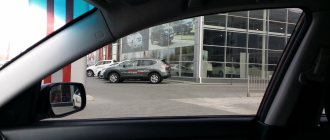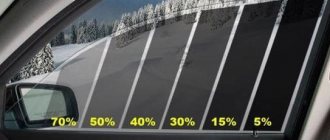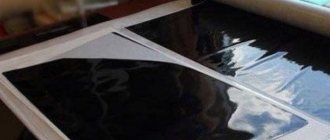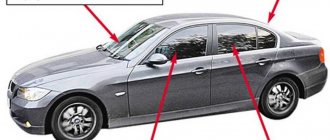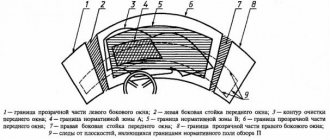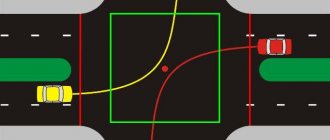How to stick and remove
To do this, it is necessary to prepare the surface to be treated.
At this stage, small debris and fluff are removed, the penetration of which under the film will lead to the formation of bubbles and swelling. Next, the process of cutting the canvas, described earlier, is carried out. Only after completing these steps should you begin directly applying the tint to the glass:
- A soap solution is applied to the surface to be treated using a hand sprayer.
- The film is peeled off from the transparent backing and moistened with a similar liquid.
- Having placed it on the glass in the desired position, smooth it from the center to the edges with light movements of the palm.
- The process of removing air and residual soap solution is carried out using forcing or a soft rubber spatula.
- Movements are carried out until there are no bubbles left under the surface of the material.
- The technology for finishing trimming the borders of tinting is disclosed a little higher.
- At the end of the work, the window is dried with a hairdryer. This step can be skipped if the machine will not be used for 2 - 3 days.
Fixing the strip at the top of the window is carried out using a similar method. At the same time, we should not forget that its height, as mentioned earlier, should not exceed 14 cm.
Car tinting may be necessary if the film needs to be replaced or at the request of a car inspector.
If in the first case, the actions are carried out thoughtfully and in a calm environment, then withdrawal after receiving a fine may occur under emotional stress, which will lead to additional difficulties.
This is explained by the fact that if you tear off the film without a hairdryer, you will have to spend several more hours removing the glue from the surface of the window.
When the surface warms up, the material peels off easily, practically without the use of sharp objects. In this case, the adhesive composition remains almost completely on the tint.
A similar situation applies to the antenna wire laid under the material. Even specialists performing this work do not give a 100 percent guarantee that these contacts will not be severed.
How to position the film
Athermal chameleon film has different percentages of light transmission at different points. Due to this unevenness, a chameleon effect can be achieved. The difference in readings on one glass can vary up to 5-6 percent. It is important to take this factor into account when gluing the film.
Light transmittance measurements are usually performed at the top of the windshield and on top of the side windows. Thus, when the film is cut from a roll, it is better to stick its edge from the top of the glass. Typically, light transmission is higher at the edges of the roll than in the middle.
Glass tinting standards
Removing tinting from windows
The main innovation of this law is the change in GOST, which regulates the level of light transmission of tinted car glass.
The new GOST involves dividing all car glass into 2 categories:
- Category No. 1 – glass that provides the driver with front visibility;
- Category No. 2 – glass that provides the driver with rear visibility.
What percentage of tint is allowed? Permitted tinting of front windows (first category) according to GOST is determined by the following light transmittance coefficients:
- windshield tinting according to GOST – 75%;
- tinting on the side front windows – 70%;
- According to GOST, tinting the rear windows of a car is not limited only if the car is equipped with side mirrors on both sides for rear view;
- In the upper area of the windshield, tinting of any light transmittance is permitted, but the width of the tinting coating is limited to 140 mm.
It is worth noting that traffic regulations permit the use of curtains for buses, window blinds and blinds for the rear windows of a passenger car, which is equipped with two rear-view mirrors on both sides.
So, the new standard allows you to curtain or tint the rear window of a car with any type of tint.
Film characteristics
Tinting the rear window of a car with a color transition to blue, matching the body color:
The “chameleon” film is significantly superior to other types of tinting coating in popularity.
This is understandable, because the material has unique properties:
- the metal is sputtered in several layers using the magnetron method;
- the film independently changes the level of darkness, depending on the degree of illumination outside;
- such protection will not allow ultraviolet and infrared radiation to pass through;
- the film blocks light, heat and ultraviolet radiation:
When an athermal film applied to glass can cause a fine
The best tint for a car
Regulatory sources regulate the possibility of operating a vehicle equipped with tinting of a certain characteristic. The windshield must transmit 75% of the rays of the light flux, and in the side front windows the figure should not be less than 70%. There is no regulation of the shading parameters intended for the equipment of the rear and rear side windows, as well as the hatch.
Each automobile glass has individual light transmission characteristics, depending not only on the car manufacturer’s standards, but also on the wear and tear of the product, as well as its operating conditions. New glass does not completely transmit all light rays. The light transmittance parameter in it corresponds to 90 - 95%. In a worn element, the characteristics can be reduced by up to 70 - 85%. When planning to equip the glass with film, you should take into account its original condition, since the automaker may have already taken care of the factory tinting. In such a situation, the feasibility of applying the film can be judged after carrying out simple calculations.
GOST requirements
According to the State Standard of the Russian Federation for motor vehicles, no more than 15% of their light should be absorbed by tinting. This rule applies primarily to front lights. Regarding the color of the light beam itself, the following requirements are defined:
- Front side lights, reversing lights, license plate lights, low and high beams, and possibly front fog lights should be white.
- The brake signal, rear parking lights and rear fog lights are red.
- The turn signal and front fog lights are yellow. Orange is also acceptable for turn signals.
Therefore, when changing the appearance of lighting equipment, it is necessary to use the material in such a way that the beam does not lose more than 15% of the light. The reversing lights should be white, and the brake signal, tail lights and fog lights should be red. Also, the turn signal should be yellow or orange.
If these conditions are met, no violations will be detected.
Film tinting Chameleon
Maximum permissible vehicle weight
Chameleon film tinting involves the use of truly high-tech materials. Currently, on the Russian market you can find two types of chameleon tinting materials - original films produced by Ultra Vision (USA) and Chinese “analogues”.
In the first case, you get excellent sun protection, excellent visibility from the interior through tinted glass and long-lasting tinting. In the second case, you only get a low price. Questionable, to put it mildly, quality and very weak sun protection justify the money saved only if you are not interested in anything other than the external visible effect. It's up to you to decide which film to use to tint the chameleon. Let's say right away that we work only with the American Mystique Ultra Vision.
Athermal tinting chameleon Mystique
Mystique Ultra Vision is a metallized film with high protection against thermal (infrared) radiation and ultraviolet radiation, which “burns out” the interior. The metal-containing layer is heterogeneous both in composition - several different metals are used, and in thickness - more than 200 very thin metal layers are sprayed during the production process.
As a result, the light transmission of the film is also uneven - at different points the difference in light transmission from the average value can reach 6 percent in both directions, which in turn creates a chameleon effect.
In addition to the original visual effect, this technology allows you to simultaneously obtain excellent transmission of visible light and the highest protection against heat and ultraviolet penetration. Mystique Light film with 93% light transmission has the same high protection from infrared and ultraviolet radiation as Mystique Night with 20% light transmission. The thermal protection of Mystique Zero film generally reaches almost 100%, which is an absolute record. The numbers speak for themselves. Comments here, as they say, are unnecessary.
| Light transmittance (average value) % | Infrared protection (average value) % | UV protection % | |
| Mystique Night | 20 | 90 | 99 |
| Mystique Zero | 70 | 99,9 | 99 |
| Mystique Optimum | 75 | 90 | 99 |
| Mystique Clima Comfort | 83 | 80 | 99 |
| Mystique Light | 93 | 90 | 99 |
The color shade of glass tinted with chameleon film depends on the lighting, viewing angle and shape of the glass. On convex surfaces, such as the windshield, blue-violet shades predominate. On flat side windows the spectrum shifts towards turquoise. Accordingly, the less light transmission the film has, the darker and more saturated the color. From almost transparent with slight tints of Mystique Light to deep dark blue Mystique Night.
Chameleon film tinting looks especially advantageous on white or light gray cars, as well as on cars of various shades of red and blue. Although this is, of course, a matter of taste.
The main differences between the chameleon films of the Mystique Ultra Vision series and their Chinese counterparts
- Thermal protection of Mystique films ranges from 80 to 99.9%, depending on the specific type of film. Chinese chameleon films block only 40% of heat rays.
- Athermal films chameleon Mystique do not have a pronounced mirror effect. Chinese analogues have a strong mirror effect.
- Mystique films are easy to form and have good heat shrinkability. Chinese ones do not mold well, when overheated they become cloudy and plasticize, forming streaks around the overheating zone - only simple (straight) glass can be tinted with them more or less efficiently.
- Mystique films do not fade, have a 5-year warranty from the manufacturer and a Russian Certificate of Conformity.
If you have chosen the Mystique chameleon tint for yourself, contact one of them. Call, make an appointment and come.
To main
What to look for when choosing chameleon tint
When choosing chameleon tint, it is better to give preference to manufacturers such as Suntek, Llumar and Ultra Vision. Mistique filters from are especially popular. This line includes materials with different light transmittance:
- Night – 20%, allowed only for use on rear windows.
- Zero – 70%.
- Optimum – 75%.
- Clima Comfort – 83%.
- Light – 93%.
For windshield and side windows, it is best to use the last two types.
It is better not to buy cheap film filters, since fakes or simply low-quality products have a strong mirror effect. In addition, such materials quickly peel off and burn out. A chameleon film purchased on the market will not have useful properties; therefore, it will not protect you and the car interior from the scorching sun, and there will be many problems with valiant employees. Therefore, it is better to overpay once, especially since famous manufacturers give a 5-year guarantee on their film filters.
Responsibility
For violating the permitted standards for tinting the front windshield, the violator faces a fine of 500 rubles.
In addition, the traffic police officer has the authority to issue an order to the car owner, obliging the latter to fix the problem within a specified period (usually 10 days), that is, remove the film.
This process takes place on the basis of the following documents:
- In case of a fine, the inspector is guided by clause 3 of Art. 12.5 of the Code of Administrative Offenses of the Russian Federation “Driving a vehicle in the presence of a malfunction or condition that does not allow its use.”
- An order against a violator is issued in accordance with the Federal Law “On Police”, Art. 13: “a police officer has the right to demand that citizens stop illegal actions...”.
If you are stopped again and it is discovered that the car owner has not complied with the terms of the legal requirement, the following administrative penalties are applied to him:
- A protocol on violation of clause 3 of Art. is drawn up again. 12.5 Code of Administrative Offenses of the Russian Federation
- In total, Part 1 of Article 19.3 of the Code of Administrative Offenses of the Russian Federation “Disobedience to the legal requirement of a police officer” is added to it. In this case, the violator can hope, at best, to receive a fine of 1,000 rubles, or at worst, receive a penalty of imprisonment for up to 15 days.
Based on this information, before tinting the windshield in violation of established standards, it is advisable to weigh all possible legal problems that may arise during the operation of the car.
In addition, it should be added that the tinting of a motorcycle windshield belongs to similar criteria, since it is documented as “glass that provides visibility to the driver.”
Therefore, for a black-painted windshield that sticks out just 10 cm above the speedometer, it is quite possible to receive the same fine as on a car.
What is the fine for athermal tinting?
The characteristic blue-violet or greenish tint of athermal film often attracts the attention of traffic police officers. The inspector has the right to stop the driver at any time for inspection. Measurements of the light transmittance of glass are made with special equipment. For the device to work correctly, the following conditions must be met:
- the surface being studied is dry and clean;
- ambient temperature – from 15 to 25 C, humidity – from 40 to 80%, atmospheric pressure – from 86 to 106 kPa;
- the device is sealed and has a certificate of conformity;
- the documents accompanying the equipment must contain a note indicating that an annual mandatory inspection has been completed;
- According to the requirements of clause 4.7 of GOST 5727-88, to determine the level of light transmission, it is necessary to take measurements of three glasses at three points and determine the average value of the obtained indicators.
The person who carries out the measurements must be a traffic police officer or have the appropriate permit.
More on the topic: Fine for not having a compulsory motor liability insurance policy
If a violation is detected, an appropriate resolution is issued. As stated in Part 3.1 of Art. 12.5 of the Administrative Code, the fine for applying athermal tinting that impairs the ability of glass to transmit light is 500 rubles. But even such a relatively small sanction is quite unpleasant for the driver.
In addition, the inspector may require immediate removal of the film. Such a requirement is contrary to the law, but it will be difficult for an untrained driver to argue that vehicles can move further with tinted windows.
Despite the fact that traffic police officers are instructed to take measurements at eye level of the person sitting behind the wheel, they often study the upper left corner, which can be problematic. Therefore, car owners should ensure that all areas of the glass comply with the standards.
Method of pasting and dismantling
Application process
The process of applying the film yourself is not too complicated. To do this you need to use the following tools and materials:
- rubber spatula;
- soft fabric;
- detergent;
- stationery knife;
- construction hairdryer
Did you know? Due to the fact that the surface with the applied film becomes smoother and more even, the polishing process will be easier.
There is no need to dismantle the optics or glass. It is enough to thoroughly clean the surface of possible contaminants, and then degrease it in any convenient way, for example, by wiping with alcohol. Next, cut out a piece of film corresponding to the size and shape of the surface to be pasted. You can use a special template or apply it to the glass and carefully trace along the contour.
Next, you have to choose whether the dry or wet gluing method is more convenient to use. Professionals unanimously point to wet, due to its practicality and guaranteed success.
In any case, proceed like this:
- heat the material with a hair dryer;
- cover the surface by applying one corner of the film;
- using a spatula and a soft cloth, smooth the material over the surface, taking care that there are no wrinkles with air (for curved glass, you need to constantly heat the material with a hairdryer to ensure that there are no air residues under the tinting);
- wait 24 hours or more for the glue to set and dry completely.
Removal
If necessary, you can always quickly remove the film. In this case, you do not need to dismantle the glass or headlights. More often, dismantling is necessary for the following reasons:
- The film began to peel off, fade, or other defects appeared on it, including discoloration and air bubbles.
- After pasting it turned out that the tint was still too dark. Withdrawal is necessary to avoid fines and other problems with traffic police officers.
- The appearance of chips or cracks in the glass in order to completely replace it or eliminate the defect.
We advise you to read how to remove old tint: is it possible to do it yourself?
It’s easier to remove it using a special service at a car service center. To withdraw yourself, you should choose one of the following methods:
- Using a steam generator or a hair dryer. You need to carefully heat it with the selected tool, but so that the glass does not burst or become deformed. The film should yield to the blade. Carefully pry the material up around the edges and remove. Proceed slowly so that there are no glue particles left on the glass.
- Through ammonia. You need to moisten the glass well with a soap solution (it is enough to dissolve 25–40 ml of liquid soap or the same amount of soap shavings in grams in 1 liter of water). Next, the glass is treated with ammonia through a spray bottle. It is advisable to work in a respirator. Then a part of a plastic bag is applied to the glass, onto which ammonia is also applied. Everything is left in this form until the sun’s rays heat up the polyethylene. In this case, the tint will begin to deform. All that remains is to simply remove it along with the polyethylene. Subsequently, the glass is washed off any remaining glue and wiped dry.
- Without heating, using a soap solution. The method eliminates the need for heating. You need to prepare a soap solution based on the calculation that for 1 liter of water you need 25–40 ml of liquid soap or solid shavings. For convenience, the prepared solution is poured into a sprayer and applied to the glass, namely to its edges. Next, they are carefully lifted and the tint is removed. It is rational to remove any remaining adhesive using a rubber scraper. The last step is to wipe the glass dry.
Chameleon film looks stylish and interesting on the windows of any vehicle. It allows you to solve problems of light transmission competently and in accordance with the law. In addition, the material has other useful functions. If everything is done correctly, the material will not “mirror”, which means that the use will be legal and will definitely please the owner.
Tinting and modifications to the design
Any actions that have been performed on the vehicle are considered changes to its design. But some of them do not need to be registered with the traffic police:
- Tuning, which is provided for in the car’s operating instructions, for example, installing a radio receiver.
- Placement of equipment or spare parts from another company certified as part of this vehicle. A common example is replacing branded wipers with non-original ones. It is enough that there is a mark on the packaging stating that the wipers are certified as part of the car brand.
- If the certificate attached to the athermal film indicates that it was tested as part of a given brand of vehicle, or the instructions for the car say about the possibility of applying tinting. In this case, it is important to ensure that the ability of the glass to transmit light meets the standard. If these conditions are not met, you will have to go through the registration procedure.
Chameleon tinting on windshield tinting film for cars
Recently, a new tint film for the windshield has appeared on the Russian auto-tuning market - chameleon. It is a development of American scientists. When glued to the windshield of a car, it gives an athermal effect and a certain shade of mysticism - you can see almost all the colors of the rainbow. The film contains several different metals, and high quality, reliability and strict adherence to production technology guarantee long-term operation of the chameleon.
What are the benefits of chameleon tinting?
A regular windshield can block infrared and ultraviolet radiation, but it does not provide complete protection. Manufacturers of chameleon tinting guarantee additional protection of around 50%
This is a very important advantage: the temperature in the cabin is much lower, the operation of the air conditioner is also reduced, although it still cannot be turned off completely. The film is perfect for tinting not only the rear window of a car, but also the windshield and front windows of doors.
The technical regulations are not violated.
Chameleon film is able to resist the harmful effects of ultraviolet rays, which is important for people who spend a lot of time traveling by car.
Another important property of the film is its high strength - during an accident, the windshield will not crumble, injuring a person, but will remain on it. The film can extend the service life of glass and makes it easier to care for, and it is much easier to wash tinted glass
In addition to UV protection, the chameleon will give the car solidity and an unusual look. It has an interesting shimmer in the sun, but does not interfere with good visibility. The chameleon has not lost the respectability of its appearance for many years. Manufacturers guarantee a minimum of 5 years of service, but in reality this period is much longer.
Despite the fact that there are many advantages, there is also a disadvantage - such tinting costs much more than conventional films, but the price corresponds to the quality.
How do the traffic police feel about this tint?
According to GOST, tinting the windshield and front windows of a car should not prevent the penetration of light by more than 30%. This is necessary to see a more complete picture of the road situation. If, after checking the car's tinting by a traffic inspector, a violation of the standards is detected, the driver receives a fine.
Chameleon film, when selected correctly, meets all necessary technical standards and will not cause any problems. To be on the safe side, you can check before completely applying the tint coating. To do this, you need to stick a small piece on the glass and take measurements using a special device. If the parameters correspond to the norm, feel free to install!
How to install chameleon tint film?
Chameleon tint film for cars is a rather fancy material. Difficulties arise during heat treatment - if it is overheated, it will change color. In addition, all errors are clearly visible on it: dust, lint, creases, and after installation this cannot be corrected. Therefore, it is better to entrust the application of chameleon tint film to a specialist. If, nevertheless, you decide to install it yourself, then read the literature and watch videos on this topic. Guided by intuition alone, you will not cope with the task!
Professionals have some tricks in their arsenal for installing chameleon tint. For example, they lift and pull back one edge to better heat the film and improve its heat shrinkage.
The next method is to place the edge of the film at a right angle, after which it is lowered onto the surface of the car glass and heated along its entire length.
Main manufacturers and types
Chameleon tint film is quite popular among motorists. In addition to all its positive qualities, it also has a different percentage of light transmission, from 20% to 93%, so everyone can choose the necessary light transmission. But for the front doors and windshield, it is best to use film with 83% and 93%. You should not install film with light transmission below the permissible parameters.
https://youtube.com/watch?v=WcrwsmRVpMo
Among the manufacturers of athermal chameleon tinting for car glass, there are two main ones: Armolan and LLumar. They have proven themselves well in the Russian tuning market. The films have excellent wear resistance and an attractive appearance.
Among the huge selection of films, motorists prefer chameleon tinting. By choosing a product from trusted manufacturers, you can be sure that it has a long service life and high quality.
Athermal toning methods
Athermal tinting is applied in two ways, which involve applying materials to the glass that can reduce the thermal conductivity properties of the glass.
Metal spraying is carried out at the car manufacturer or in car service centers. According to reviews from car enthusiasts, service centers for the most part do not have the necessary equipment, for example, vacuum chambers, and therefore the quality of spraying leaves much to be desired.
Factory tinted glass is produced with low thermal conductivity and provides excellent protection from ultraviolet radiation. Such glasses can be distinguished by their green or blue tint.
Athermal film is perhaps the only film that can be glued to front windows and meet the requirements for light transmission. The film can be installed quite easily in any car service center. With certain skills, this procedure can be performed independently.
For athermal tinting, films of two series can be used:
- ATR is neutral and has little eye strain;
- LA blue is less favorable for the eye, as fatigue sets in quickly.
Is athermal tinting allowed or not Chameleon What the law says
- The darkening of the top stripe on the windshield is not stipulated by law. Only its width is strictly regulated (should not exceed 14 cm);
- Windshield. First of all, any inspector will check it. The throughput should not be less than 75%;
- Front door glass. Here the light transmittance must be at least 70%. Otherwise, you will be fined;
- Rear glass of the car. The darkness of these glasses was not regulated by law. Here the driver can relieve himself and stick a film with at least 5% transmittance;
- Do not forget, it is strictly forbidden to use tinting with a mirror effect. The blinding glare it creates has already caused more than one accident.
AutoFlit.ru
Legal requirements
Tinting with a density of 85 percent is allowed. If you look at GOST 33997-2016, you can see that even for the windshield the minimum level of light transmission is 70%, and for the rest of the glass there are no additional instructions at all. The same is indicated in the Technical Regulations of the Customs Union.
This kind of film is completely permitted. The fact is that the glass itself blocks 3–7% of light rays. It turns out that by gluing a film with a transparency of 85%, you will get a real transparency of 78%. This is quite enough to pass the test.
Only mirror film and chameleon are prohibited. According to experts, such tinting can reflect headlights and blind other road users. Although this film looks great both in reality and in photos.
Is chameleon tinting allowed according to GOST?
Sometimes even air conditioning cannot save you from the heat inside your car. The only desire in such conditions is to leave the vehicle as soon as possible. However, there is an alternative. You can protect yourself and the car interior from the sun using chameleon tinting.
Unlike most dense tinting films, it has a high throughput and is permitted by law. It can also significantly improve the appearance of the car. Its darkened iridescent effect adds solidity to the car's exterior.
The uniqueness of the film
The coating contains about 20 protective layers applied by magnetron sputtering. The film does not fade and provides light transmission in the range of 83–90%. The interior of the car practically does not heat up, and you can completely dispense with air conditioning. This film can be used to tint not only rear windows, but also front windows, including the windshield, without violating GOST requirements.
Advantages of film
- • Increases the strength of glass. In the event of an accident or a strong impact, glass fragments will not scatter throughout the cabin; the film will hold them in place. By sticking it on, you will ensure the safety of yourself and your passengers.
- • Extends the service life of glass. The film protects the glass from scratches and chips.
- • Resists ultraviolet rays. The film protects against sunburn. The furniture in the cabin does not fade. When illuminated by halogen headlights, the tint becomes transparent and remains visible.
- • Guarantees long-term operation. The service life of the film will be long, it will last for several seasons. It adheres firmly to the glass and does not peel off or scratch.
- • Improves vehicle design. Depending on the lighting, the film shimmers in different shades and imitates the appearance of premium car glass.
Some traffic police officers confuse chameleon film with the prohibited mirror film. However, upon inspection, a high percentage of light transmittance is detected and released. When choosing a tint, rely on GOST - then you will not have problems with law enforcement officers on the roads.
"Chameleon" meets GOST requirements
The light transmittance of the film is checked using a taumeter and must comply with technical regulations - at least 75%. From 2021, in accordance with amendment No. 3 to GOST 5727-88 “...The light transmittance of vehicle windshields must be at least 75%, front door glass - at least 70%, other glass - is not standardized. Windshields painted in the paste and tinted must not distort the correct perception of white, yellow, red, green and blue."
How to determine the total percentage of light transmission of glass with film
New car glass does not have 100% light transmittance. In reality it reaches approximately 90%. For used glass, this value is in the range of 75–80%. Some cars have their own factory tint. The film throughput also varies. The final degree of light transmission is determined by multiplying the composite indicators.
There is another way. Use it to be on the safe side and make sure your calculations are accurate. Place a piece of film on the car window and measure the value using a taumeter. Remember, the device has an error of 2%. By correctly calculating light transmittance and selecting a film model, you can avoid fines and conflict situations with traffic police officers.
At Bitstop auto glass stations you can order any type of tinting. Our service centers are located throughout the country.
Advantages and disadvantages
The athermal film “chameleon” has many positive properties:
in the event of an accident, the film, due to its increased strength, can retain glass fragments and protect passengers from injury, and perhaps even save their lives;
But, in addition to the advantages, there are also disadvantages:
- high price;
- in particularly sunny weather, the film may have a light transmittance of less than 70%, which will lead to a fine if the driver is stopped by a traffic police officer;
- complexity of pasting, high risk of defects during self-installation.
Reviews from drivers who have chosen chameleon film for their car are both positive and negative: “I’ve been driving with film on my windshield for six months. The traffic police officers were never interested in tinting, only other drivers.” “I installed the chameleon tint all around. The appearance of the car immediately changed. I’ve been driving for three years now, everything is fine, visibility hasn’t deteriorated.” To summarize, we can say that chameleon tinting is the best value for money. Although such tuning is significantly more expensive than its analogues, its quality characteristics and longer service life fully justify the price.
This film will last on car windows for many years, which means the investment will pay off. As for the legality of the coverage, then. As car enthusiasts note, traffic police inspectors rarely find fault with car tinting.
If you use high-quality material, the light transmittance of the glass will remain within normal limits.
Types of products
One of the most popular products of the Ultra Vision brand are the Mystique series products. They are able to change their color, as well as the level of illumination. Tinting of the Mystique series is carried out using ultra-modern machines that allow thin coating of up to 20 layers of different metals using a special technique. Thanks to this, the film will not fade, will remain transparent and maintain a high degree of light transmission (from 83 to 90% depending on the model). The Clima Comfort function allows you to save fuel, as the temperature in the cabin remains at an acceptable level for the driver and passengers.
New for 2015 in Russia is the Deep Light model. It combines the advantages of Clima Comfort and Light and has a high degree of protection against infrared radiation (more than 90%). It also has a stylish appearance, reminiscent of tuning a Porsche Cayenne or Range Rover. If we compare this model with Clima Comfort, then Deep Light is equipped with less reflectivity and has a less pronounced iridescent effect that it will attract less attention from others. The appearance of the film changes depending not only on the viewing angle, but also on the height - on sedans the product has a blue tint, and on tall cars (SUVs) it appears purple. Inside it seems completely transparent, although when rolled it has a green tint.
In addition, a tint with the same name Mystique, but from a different manufacturer - American Standard Window Film, is popular among drivers. It is distinguished by high cost along with high quality. The use of such a film allows you to regulate the temperature in the cabin.
Car tinting with ASWF Mystique film
The following models are also popular among Russian drivers:
- Armolan tinting;
- Llumar tinting.
They are somewhat cheaper, but are distinguished by durability and high performance characteristics. Also, drivers, in pursuit of the overflow effect, sometimes purchase products from Korean or Chinese brands. They do not have high performance indicators; over time, they lose their properties or are completely deformed as a result of exposure to sunlight.
What athermal film is acceptable?
Athermal tinting is conditionally permitted, but it can be applied to glass only if a number of rules are observed, which some manufacturers neglect.
Most often the question arises whether it is allowed to glue athermal film to the windshield. Yes, but its light transmittance level should not be lower than 70%. You will have to spend time taking measurements, but if the car is new, the efforts will be justified - the standard result after installing the film is 76.5% light transmittance, which corresponds to the norm. After several years of active use, the glass may become cloudier, so it is recommended to repeat measurements periodically.
More on the topic: Is it possible not to sign the protocol and resolution of the traffic police?
Athermal tinting “Chameleon”, capable of changing light transmission depending on the intensity of light, often reflects quite strongly, so the driver may face problems when passing the test. This feature of “Chameleon” is due to the fact that this type of film consists of many metallized layers, which not only change the color of the tint, but also mirror the image.
This film may have different light transmittance depending on the time of day and temperature. Indicators may also vary across the width of the film. It is thanks to these features that the “chameleon” effect is achieved. Unfortunately, models of the domestic automobile industry and inexpensive foreign cars with chameleon film will not comply with the standards established by law, especially if they have been in use for more than one year, and there are cracks or cloudy areas on the glass. There is only one way out - replace the glass with new ones.
Purple athermal tint is most often installed on the rear window because it darkens the windows significantly. It is only allowed to be glued to windows with a light transmittance of at least 91%. This indicator can only be found in new glasses. In addition, the result largely depends on the quality of installation. In the worst case, the scatter can reach 7% in different areas of the glass.
How to choose the right tint
The choice of tint must be approached responsibly. The material must suit the light transmittance, color scheme and other characteristics
In principle, it is enough to pay attention to two main factors, namely:
- The film should transmit 80% of the light if the car has white glass, since the glass surface tends to block radiation.
- For vehicles with greenish or bottle-colored glass, the use of materials with shading up to 90% is allowed.
Important! You can use a darker tint for covering the rear windows, but the material must transmit at least 60% of the light, due to its ability to “mirror” (the use of materials with a mirror effect is unacceptable). When choosing, be sure to choose the manufacturer correctly
Today, film is produced in different countries. American products that collect excellent reviews from users are considered the best. They claim that it maintains performance characteristics for 5 years. For example: Chinese analogues become cloudy and begin to peel off after 2–3 years of use, and therefore require replacement
When choosing, be sure to choose the manufacturer correctly. Today, film is produced in different countries. American products that collect excellent reviews from users are considered the best. They claim that it maintains performance characteristics for 5 years. For example: Chinese analogues become cloudy and begin to peel off after 2–3 years of use, and therefore require replacement.
Which coating to choose: varnish or film?
At the moment, the most popular, due to their availability and efficiency, are two types of car lighting tuning: film and varnish. But each of these methods has its pros and cons.
Vinyl, matte, glossy film:
- Easy to remove.
- The headlight is protected from scratches.
- Possibility of use in individual areas while maintaining the level of light transmission.
- Turns yellow and fades within 3-5 years.
- Most often used for front lights.
Acrylic lacquer:
- It is difficult to change the tone or remove the coating.
- Cheap compared to film.
- Possibility of obtaining a unique shade.
- Risk of uneven application.
- Reduces dispersion and visibility when driving at night.
- Mainly used for rear lights.
